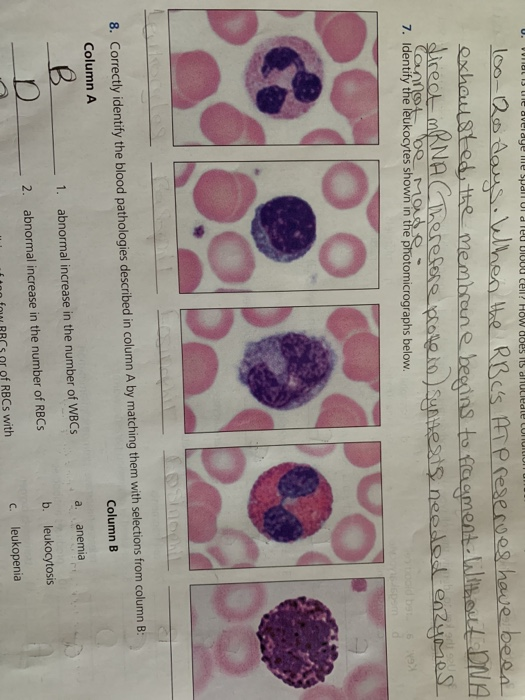Correctly Identify the Blood Pathologies Described in Column a
Condition of too few RBCs or of RBCs with leucopenia. Identify the Leukocytes shown in the photomicrographs below 1.

Developmental Milestones Pretend City Children S Museum Developmental Milestones Pediatric Nursing Nursing Study
Abnormal increase in the number of WBCs a.

. Identify the type of white blood cell indicated in each microscopic image. Then arrange the sentences into a logical paragraph order to describe the process of healing a fracture in bone. Abnormal increase in the number of WBCs a.
Column A Column B _____ 1. Column A Column B. 8- Correctly identify the blood pathologies described in column A by matching them with selections from column B.
Leukopenia hemoglobin deficiencies 4. Abnormal increase in the number of WBCs a. View Screen Shot 2021-09-19 at 84559 AMpng from CTE SCI322 at University of Mindanao - Main Campus Matina Davao City.
Correctly identify the blood pathologies described in column A by matching them with selections rom column B Abnormal increase in the number of WBCS - Leukocytosis Abnormal increase in the number of RBCS- Polycythemia. Identify the causes of the pathology involved Upon successful completion of this exercise the reader should be able to. The total blood volume in the average adult is about 4-5 liters in females and 5-6 liters in males.
Abnormal increase in the number of RBCs leukocytosis _____ 3. Drag and drop each label. Condition of too few RBCs or of RBCs with c.
Correctly identify the blood pathologies described in column A by matching them with selections from column B. Abnormal decrease in the number of WBCs d. Correctly identify the blood pathologies described in column A by.
Column A Column B. On the third column give at least 3 testsactivities that are done in each section. Correctly identify the blood pathologies described in column A by matching them with selections from column B.
Access Human Anatomy Physiology Laboratory Manual Fetal Pig Version Update 10th Edition Chapter E29 Problem 8E solution now. Each label describes an aspect of either coagulation or agglutination which are illustrated in the photographs. Condition of too few RBCs or of RBCs with c.
Abnormal increase in the number of RBCs b. Abnormal increase in the number of WBCs a. Place a single word into each sentence to make it correct.
Correctly identify the blood pathologies described in column A by matching them with selections from column B. Condition of too few RBCs or of RBCs with hemoglobin deficiencies c. From memory describe the structural characteristics of each of the following blood cell types as accurately as possible and note the percentage of each in the total white blood cell population.
Review sheet exercise 29 blood Instructors may sign a portion of the Review Sheet. Textbook Solutions Expert Tutors Earn. Condition of too few RBCs or of RBCs with hemoglobin deficiencies 4.
Abnormal increase in the number of WBCs anemia _____ 2. On the second column identify and describe the subdivision of pathology that is at work in each section. Note the percentage of each in the total white blood cell populatiOryo eosinophils.
Abnormal increase in the number of RBCs 3. Column A Column B 1. Abnormal decrease in the number of.
Abnormal decrease in the number ofWBCs 30 Column B a. Abnormal increase in the number of RBCs b. 4 abnormal increase in the number of WBCs abnormal increase in the number of RBCs.
Column A Column B. Correctly identify the blood pathologies described in column A by matching them with selections from column B. Name the cells in this peripheral blood smear.
However all new growths are not neoplasms since examples of new growth of tissues and cells also exist in the processes of embryogenesis. Answer Educational Computing Homepage Curriculum Homepage Histology Homepage Histology Courseware Study. View review sheet exercise 29 blood Instructors may sign a portion of thedocx from NUR MISC at Dhaka City College.
Our solutions are written by Chegg experts so you can be assured of the highest quality. Correctly identify the blood pathologies described in column A by matching them with selections from column B. 8 identify the blood pathologies described in column A by matching them with selections from column B.
Clinical Chemistry General Pathology 1. SECTION SUBDIVISION OF PATHOLOGY 3 TESTS IN EACH SECTION 1. Athletes abuse erythropoeitin EPO because it.
Abnormal increase in the number of RBCs b. 24h Urine Uric Acid 3. N eoplasia means new growth and a new growth is called a neoplasm.
Correctly identify the blood pathologies described in column A by matching them with selections from column B. Terms in this set 118 Blood and its fibers are a type of loose reticular connective tissue. Abnormal increase in the number of WBCs abnormal increase in the number of RBCs condition of too few RBCs or of RBCs with hemoglobin deficiencies abnormal decrease in the number of WBCs Column B b.
He liquid portion of blood is called plasma and plasma makes up about 75 of the total blood volume. Abnormal increase in the number of RBCs b. Correctly identify the blood pathologies described in column A by matching them with selections from column B.
Abnormal increase in the number ofWBCs 2. Increases the red blood cell supply which brings more oxygen to muscle cells. Any break in a bone is called a FRACTURE and repair is done in stages by the body.

Solved 20 Review Sheet Exercise Blood Lab Time Date Name Chegg Com

Solved To Reproduce Or Repair Damage Caused To It During Chegg Com

Solved List The Formed Elements Present In The Blood And 4 Chegg Com

Comments
Post a Comment